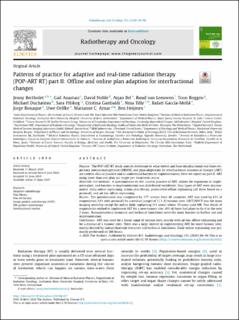| dc.contributor.author | Bertholet, Jenny | |
| dc.contributor.author | Anastasi, Gail | |
| dc.contributor.author | Noble, David | |
| dc.contributor.author | Bel, Arjan | |
| dc.contributor.author | van Leeuwen, Ruud | |
| dc.contributor.author | Roggen, Toon | |
| dc.contributor.author | Duchateau, Michael | |
| dc.contributor.author | Pilskog, Sara | |
| dc.contributor.author | Garibaldi, Cristina | |
| dc.contributor.author | Tilly, Nina | |
| dc.contributor.author | García-Mollá, Rafael | |
| dc.contributor.author | Bonaque, Jorge | |
| dc.contributor.author | Oelfke, Uwe | |
| dc.contributor.author | Aznar, Marianne C. | |
| dc.contributor.author | Heijmen, Ben J.M. | |
| dc.date.accessioned | 2021-06-24T06:59:01Z | |
| dc.date.available | 2021-06-24T06:59:01Z | |
| dc.date.created | 2021-02-10T16:50:08Z | |
| dc.date.issued | 2020 | |
| dc.identifier.issn | 0167-8140 | |
| dc.identifier.uri | https://hdl.handle.net/11250/2760991 | |
| dc.description.abstract | Purpose
The POP-ART RT study aims to determine to what extent and how intrafractional real-time respiratory motion management (RRMM), and plan adaptation for interfractional anatomical changes (ART) are used in clinical practice and to understand barriers to implementation. Here we report on part II: ART using more than one plan per target per treatment course.
Materials and methods
A questionnaire on the current practice of ART, wishes for expansion or implementation, and barriers to implementation was distributed worldwide. Four types of ART were discriminated: daily online replanning, online plan library, protocolled offline replanning (all three based on a protocol), and ad-hoc offline replanning.
Results
The questionnaire was completed by 177 centres from 40 countries. ART was used by 61% of respondents (31% with protocol) for a median (range) of 3 (1–8) tumour sites. CBCT/MVCT was the main imaging modality except for online daily replanning (11 users) where 10 users used MR. Two thirds of respondents wished to implement ART for a new tumour site; 40% of these had plans to do it in the next 2 years. Human/material resources and technical limitations were the main barriers to further use and implementation.
Conclusions
ART was used for a broad range of tumour sites, mainly with ad-hoc offline replanning and for a median of 3 tumour sites. There was a large interest in implementing ART for more tumour sites, mainly limited by human/material resources and technical limitations. Daily online replanning was primarily performed on MR-linacs. | en_US |
| dc.language.iso | eng | en_US |
| dc.publisher | Elsevier | en_US |
| dc.rights | Navngivelse 4.0 Internasjonal | * |
| dc.rights.uri | http://creativecommons.org/licenses/by/4.0/deed.no | * |
| dc.title | Patterns of practice for adaptive and real-time radiation therapy (POP-ART RT) part II: Offline and online plan adaption for interfractional changes | en_US |
| dc.type | Journal article | en_US |
| dc.type | Peer reviewed | en_US |
| dc.description.version | publishedVersion | en_US |
| dc.rights.holder | Copyright 2020 The Authors. | en_US |
| cristin.ispublished | true | |
| cristin.fulltext | original | |
| cristin.qualitycode | 1 | |
| dc.identifier.doi | 10.1016/j.radonc.2020.06.017 | |
| dc.identifier.cristin | 1888649 | |
| dc.source.journal | Radiotherapy and Oncology | en_US |
| dc.source.pagenumber | 88-96 | en_US |
| dc.identifier.citation | Radiotherapy and Oncology. 2020, 153, 88-96. | en_US |
| dc.source.volume | 153 | en_US |

